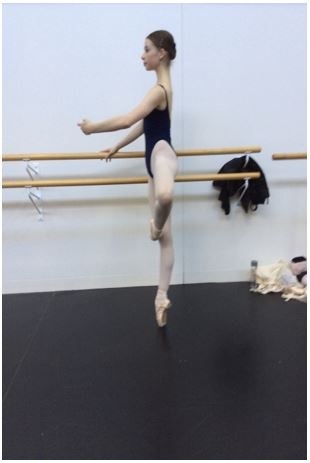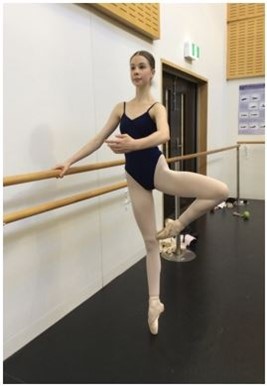Maintaining Correct Alignment When Training Positions Retiré or Passé - (to withdraw or to pass)
Author: Maggie Lorraine on behalf of the IADMS Education Committee

Pictured: Rebecca Blenkinsop
Photo by: Maggie Lorraine
In the last post from the IADMS Education Committee “Dancing with the pelvis” the authors focused on pelvic alignment and its relevance to movement execution in the studio. When reading this post on the retiré position, it would be useful to refer back to information posted on previous IADMS posts, as each new post now reinforces the anatomical truths that guide us as teachers. To quote Clara Fischer and Elsa Urmston,“We have all learned from experience: proper alignment is one of the basic building blocks for achieving the aesthetic line and form required for dance technique.”
Dancers and teachers cannot underestimate the importance of achieving correct pelvic alignment when practising or performing the retiré position, as it is a key position for the successful performance of many dance movements. Pirouettes and developpé are clearly affected by the placement of this position and the retiré influences the execution of many steps of virtuosity.
In this photograph (above) Rebecca is demonstrating a well aligned retire position en pointe. Note that her head is centred over her foot en pointe.
Points to remember when practising retiré:
Commencing in 5th position
The Supporting Leg.
- Full transference of weight over the center of the supporting foot as the gesture leg leaves the floor. The dancer should be ready to rise to demi pointe without further adjustment of weight by ensuring the foot is controlled against the floor. Check that there is no pronation of the supporting foot.
- Lengthen through the supporting hip maintaining pelvic alignment and the control of turnout of the supporting leg.
The Gesture Leg
- The foot and ankle of the gesture leg retain alignment, no sickling or winging of the foot.
- The thighbone or femur inserts into the hip socket or acetabulum from the front of the pelvis and the rotation of the thigh should occur from the turnout in the acetabulum, which is initiated by the deep rotator muscles.
- The continued control of the deep rotator muscles and core muscles as the gesture leg passes through petit retiré to full retiré.
- Maintain control of the femur extending from the acetabulum and maintain the knee, ankle and foot alignment. The appearance of the position will vary from student to student depending on their personal pelvic structure, however students should be encouraged to work with their respective physiques rather than meeting a “prescribed” position.
- Remember “turnout is a verb” and the turnout muscles should continue to be active throughout.
Thus the retiré position should demonstrate pelvic, shoulder, and head alignment.
Points to consider:
- On the point of transference of weight from two feet to one foot it must be emphasized not to sink into the supporting hip as this action will result in loss of rotation and control in the supporting side.
- The hip of the gesture leg must not be raised by lifting the thigh higher than can be controlled by the dancer. This will result in the weight moving off the supporting leg and pelvic alignment will be lost. The deep rotators cannot recruit efficiently when pelvic alignment has been sacrificed
- Placing the foot too high at the side of the supporting knee can be problematic for some, as not all dancers possess the range of movement in the hip to accommodate this position of the foot and retain pelvic alignment. Many will anteriorly tilt their pelvis, which will result in loss of turnout, and the gluteal muscles will overwork to accommodate the position of the thigh.
When viewing this photograph (below, left) of Rebecca practising retiré it would appear that her retiré is turned out. Observing the same retiré from the side (below, right) we can see that Rebecca is far from turned out, her thigh is in reality inwardly rotating.


Please follow this link to see how perfect alignment can work in steps of virtuosity - enjoy! In this video Isabela Rodriques has an unfortunate slip when performing the coda of the Diana & Acteon pas de deux but later goes on to repeat the whole coda. You will see that in both of these dancers the gesture leg in retiré is placed in front of the bodyline.
Maggie Lorraine
IADMS Dance Education Network Subcommittee
Leading Teacher in Ballet
The Victorian College of the Arts Secondary School